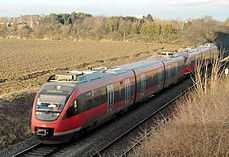Waggonfabrik Talbot
Coordinates: 50°47′09″N 6°06′39″E / 50.785848°N 6.110717°E
| Industry | Railway rolling stock manufacturing |
|---|---|
| Successor | Bombardier Transportation GmbH (part of) |
| Founded | 1838 |
| Headquarters | Aachen, Germany |
| Products |
Wagons, coaches later Multiple units, trams, double deck rail vehicles |
Number of employees | 500 (January 2011)[1] |
Waggonfabrik Talbot was a rolling stock manufacturer founded in Aachen, Germany in 1838. The company was an early pioneer of self discharging freight wagons, and in the latter part of the twentieth century a major supplier to the Dutch State Railways (Nederlandse Spoorwegen).
In the 1990s the company developed the Talent passenger train, and was acquired by Bombardier Inc.. As of 2011 company is part of Bombardier GmbH., and manufacturers passenger rolling stock. Since takeover it is also referred to as Bombardier Talbot.
Bombardier announced the closure of the factory in 2012.
History

In 1838, Pierre Pauwels and Hugo Talbot founded the Eisenbahn-Waggon-Fabrik Pauwels & Talbot Aachen (Pauwels & Talbot railway wagon factory) near the Adalbert gate (Adalbertsot) on Adalbertsteinweg.[2][3] The company was founded to supply wagons to the to Rheinische Eisenbahn-Gesellschaft (Rhenish Railway Company),[4] and was one of the earliest wagon factories in Germany.[5]
Belgian and English industrial knowledge played a role in the early wagonworks, in particular English wagon technology, and Belgian engineers acting as technology transferists;[6] Pauwels, a Belgian stagecoach and wagon maker, had the experience to oversee a wagon-making business, having already delivered wagons from his Brussels wagonworks to the Leipzig-Dresdner Eisenbahn-Compagnie (Leipzig-Dresden Railway Company), whilst Talbot had the necessary Prussian citizenship to be eligible for the Rhenish Railway contract.[4] New production facilities were opened at in the Nordbahnhof area in 1845.[2]
After the initial contract, the company sought orders but was hampered by a dependence on external suppliers, and by disruption due to the revolutions of 1848 in the German states,[3] as well as the distance to the markets;[6] because of transportation difficulties, a factory was built in Heidelberg in 1842.[4]
Several early German railways were supplied with wagons from Aachen,[3] including the Leipzig-Dresdner Eisenbahn-Compagnie (Leipzig–Dresden Railway Company),[4] the München-Augsburger Eisenbahn-Gesellschaft (Munich-Augsburg Railway Company), Köln-Mindener Eisenbahn-Gesellschaft (Cologne-Minden Railway Company), Düsseldorf-Elberfelder Eisenbahn-Gesellschaft (Düsseldorf-Elberfeld Railway Company), Main-Neckar-Bahn (Main-Neckar Railway), Bergisch-Märkische Eisenbahn-Gesellschaft (Bergisch-Märkische Railway Company) and Großherzoglich Badische Staatseisenbahnen (Grand Duchy of Baden State Railway);[7] most of the early lines in Southern Germany got wagons from the plant.[4]
After Hugo Talbot's death in 1850, his sons with Peter Herbrand ran the company; after 1855 it was named as Talbot & Herbrand.[4] A new factory was built on Jülicher Straße in 1860.[2]
In 1891, George Talbot developed a new type of wagon - the 'self discharging wagon', which became a major source of sales. A modern plant along North American lines was added in ''Jülicher Straße in the 1890s, with modern equipment including air hammers, rivetting machines, and electric power for machines. By 1900 the plant employed up to 400 workers.[2]
The factory site expanded in the early 1900s; by 1929 the factory employed 1700, and had a full order book, including a large order for express coaches for the Paris–Versailles line. After the interruption of the 1930s Great Depression, a new factory hall was completed, the Tannhäuserhalle. During the Second World War, the factory was heavily damaged, being hit by over 3000 incendiary bombs. The company recovered during the 1950s, and by 1957 accounted for half of German exports of rolling stock.[2]
After 1968 the company became the major supplier of rolling stock to the Dutch Railways, Nederlandse Spoorwegen (NS).[note 1][1]

In 1994 the Talent multiple unit was developed, and in 1995 the factory was acquired by Bombardier.[1] The Talent soon entered service in the rail system of Germany,[9] Austria[10] and Norway.[11]
In late 2012 Bombardier announced the closure of the plant.[12][13] The plants remaining contracts were expected to be completed by mid-2013, with lack of orders from the Netherlands contributing to the closure.[14]
Notes
References
- ↑ 1.0 1.1 1.2 "Bombardier Germany : Aachen". de.bombardier.com. Bombardier Transportation. Retrieved 30 June 2011.
- ↑ 2.0 2.1 2.2 2.3 2.4 "Rheinische Industriekiltur : Aachen Talbot". www.rheinische-indsutriekultur.de (in German). Rheinische Industriekultur e.V.
- ↑ 3.0 3.1 3.2 Hans Pohl (2001). Die rheinischen Sparkassen: Entwicklung und Bedeutung für Wirtschaft und Gesellschaft von den Anfängen bis 1990 (in German). Franz Steiner Verlag. p. 25. ISBN 3-515-07846-0.
- ↑ 4.0 4.1 4.2 4.3 4.4 4.5 Hartmut Schainberg (April 1997). Die belgische Beeinflussung der Frühindustrialisierung im Aachener Raum, ca. 1820-1860 (thesis: Universität Trier ). ubttest.opus.hbz-nrw.de (Universitätbibliothek Trier). pp. 207, 298–302, 307.
- ↑ Edmund Heusinger von Waldegg (1870). Handbuch für specielle {spezielle} Eisenbahn-Technik: Bd. 2, Der Eisenbahn-Wagenbau in seinem ganzen Umfange (in German) 2. Engelmann. p. 543.
- ↑ 6.0 6.1 Silke Fengler; Stefan Krebs. "Die Aachener Frühindustrialisierung: Belgisch-deutscher Technologietransfer 1815-1860". www.histech.org (in German). Der Diffusionsprozess der Dampfmaschine im Aachener Raum.
|chapter=ignored (help) - ↑ "Aachener Eisenbahngeschichte". www.wisoveg.de (in German). Mit der Eisenbahn kommt die Industrie. Retrieved 30 June 2011.
- ↑ A. J. Veenendaal (2001). Railways in the Netherlands: a brief history, 1834-1994. Stanford University Press. p. 209. ISBN 9780804739474.
- ↑ "Diesel Multiple Unit TALENT Class 643.2 - Germany". Retrieved 3 July 2011.
- ↑ "Electrical Multiple Unit TALENT for Regional Service - Austria". Retrieved 3 July 2011.
- ↑ "Diesel Multiple Unit TALENT Class 93 - Norway". Retrieved 3 July 2011.
- ↑ Bombardier Announces Financial Results for the Third Quarter Ended September 30, 2012 (Press release), Bombardier, 7 November 2012
- ↑ "Bombardier schließt Bahn-Fahrzeugwerk in Aachen", www.welt.de (in German), 18 October 2012
- ↑ "Bombardier-Werk in Aachen schließt: Druck auf Bombardier wächst", www1.wdr.de (in German), 19 October 2012
External links
| Wikimedia Commons has media related to Waggonfabrik Talbot. |
- "Resultaten van uw zoekopdracht : Fabrikant: "Talbot"" [Search result for "Talbot" as manufacturer on the Netherlands Museum (rail) Database]. nmld.locaalspoor.nl (in Dutch). Nederlandse Museummaterieel Database.